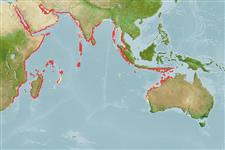>
Blenniiformes (Blennies) >
Tripterygiidae (Triplefin blennies) > Tripterygiinae
Etymology: Enneapterygius: Greek, ennea = nine times + Greek, pterygion = little fin (Ref. 45335).
More on author: Rüppell.
Environment: milieu / climate zone / depth range / distribution range
นิเวศวิทยา
เกี่ยวกับทะเล,น้ำเค็ม สัตว์น้ำหน้าดิน; ระดับความลึก 3 - 20 m (Ref. 30874), usually ? - 10 m (Ref. 12476). Tropical
Western Indian Ocean: restricted, Persian Gulf (Ref.80050); Red Sea south to northern Natal, South Africa and east to India.
ขนาด / น้ำหนัก / Age
Maturity: Lm ? range ? - ? cm
Max length : 3.0 cm SL เพศผู้/กระเทย; (Ref. 88983)
Short description
เครื่องมือที่ใช้ในการแยกชนิดสัตว์,สิ่งมีชีวิตออกจากกัน | สัณฐานวิทยา | ความยาวต่างๆ
เงี่ยงครีบหลัง (รวม) : 15 - 17; ก้านครีบอ่อนที่หาง (รวม) : 10 - 11; เงี่ยงครีบก้น: 1; ก้านครีบอ่อนที่ก้น: 20 - 21. This species is distinguished by the following characters: D III + XII-XIV (usually XIII) + 10-11; A I, 20-21; pectoral rays 13-14: 3-4 + 3-4 + 6-7 (usually 14:4+3+6). LL, pored scales 12, notched scales 25-28, starting at 2 scale rows below the end of the pored series; total lateral scales 29-30; transverse scales 2/4; nape and abdomen scaleless, dorsal and anal fin bases also without scales. Body depth 5.3-6.0 in SL. Head 3.6-3.9 in SL; eyes large, diameter 3.0-3.4 in head length; supraorbital/orbital cirrus small, lobate; supratemporal sensory canal U-shaped; dentary pores 2+2+2. Male first dorsal fin (sometimes more than twice) higher than second; equal in height in females. Key features are: first dorsal fin very tall; body translucent; first dorsal fin yellow; male chest and pelvic fins black, mouth corners red, eye spots deep blue below the eyes; females eye stripe brown below, pectoral-fin base also with brown stripe (Ref. 57774, 88983).
Known from inshore continental waters (Ref. 12476). Adults inhabit bays and sheltered lagoons, close to reef base, on a silty sand or mud substrate, often on stones and dead corals of the same color. Eggs are hemispherical and covered with numerous sticky threads that anchor them in the algae on the nesting sites (Ref. 240). Larvae are planktonic which occur primarily in shallow, nearshore waters (Ref. 94114). This is the first tripterygiid that has been described from the Red Sea (Ref. 88983).
Life cycle and mating behavior
Maturities | การสืบพันธุ์ | Spawnings | Egg(s) | Fecundities | ตัวอ่อน
Randall, J.E., 1995. A review of the triplefin fishes (Perciformes: Blennioidei:Tripterygiidae) of Oman, with descriptions of two new species of Enneapterygius. Rev. Fr. Aquariol. 22(1-2):27-34. (Ref. 12476)
IUCN Red List Status (Ref. 130435)
Threat to humans
Harmless
Human uses
เครื่องมือ
Special reports
Download XML
แหล่งที่มาจากอินเตอร์เน็ต
Estimates based on models
Preferred temperature (Ref.
123201): 25 - 29.3, mean 28 °C (based on 1085 cells).
Phylogenetic diversity index (Ref.
82804): PD
50 = 0.5000 [Uniqueness, from 0.5 = low to 2.0 = high].
Bayesian length-weight: a=0.00562 (0.00258 - 0.01228), b=3.08 (2.89 - 3.27), in cm total length, based on LWR estimates for this (Sub)family-body shape (Ref.
93245).
ระดับชั้นอาหาร (Ref.
69278): 3.1 ±0.3 se; based on size and trophs of closest relatives
ความสามารถในการกลับคืนสู่ปกติ (Ref.
120179): ความสูง, เวลาต่ำสุดที่จะทำให้ประชากรเพิ่มขึ้นเป็น 2 เท่าใช้เวลาน้อยกว่า 15 เดือน (Preliminary K or Fecundity.).
Fishing Vulnerability (Ref.
59153): Low vulnerability (10 of 100).
